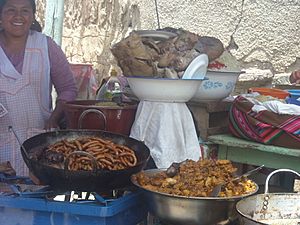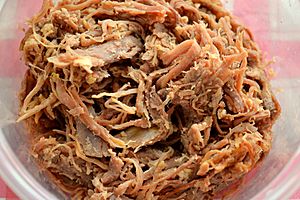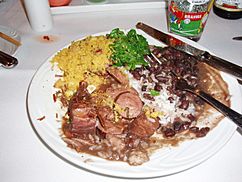South American cuisine facts for kids


South American cuisine is a super interesting mix of flavors! It gets its unique taste from many different cultures that have come together in South America. The biggest influences come from Native American, African, Spanish, Italian, Portuguese, and even Indian backgrounds. But really, it's a blend of European, North American, and local foods. The types of food and cooking styles change a lot depending on the different regions across the continent.
Contents
Amazing Foods from South America
The Amazon basin in South America is full of fresh fish and yummy tropical fruits. The Pacific Ocean also provides lots of seafood. You can find huge king crabs in the south and plenty of lobsters near the Juan Fernández Islands. Even tiny Antarctic krill have been discovered recently! Tuna and other tropical fish are caught all around the continent, especially near Easter Island.
South America has many flat plains, which are great for growing foods like grains, potatoes, and quinoa. In the Patagonia region, which is in southern Argentina, many people raise sheep and cattle. In Brazil, a famous traditional dish is feijoada. It's a hearty stew made with beans, beef, and pork. Eating Rice and beans is also very common in Brazil.
Peruvian cuisine is greatly shaped by the old Incan culture. Many people across the continent enjoy carne asada, which is grilled meat. It's popular to grill outdoors, like in asado or churrasco parties.
Shredded beef is a common food all over South America and Latin America. It's served with many different kinds of dishes.
Food Across South America
Andes Mountain Flavors

The food in the Andes mountains is strongly influenced by the indigenous peoples who have lived there for centuries. The main foods are still corn, potatoes, and other root vegetables called tubers. Some unique meats from this area include llama (especially in Peru) and guinea pig (eaten in Chile, Bolivia, Peru, Colombia, and northwest Argentina). In places with fresh water, people often eat trout.
Chupe andino is a name for different kinds of stews and soups made in the Andes mountains. A very important drink is chicha. Other popular dishes include humitas, locro, chanfaina, arepas, and quimbolitos (which are sweet tamales). Peppers are also used a lot. A famous dish from the Peruvian Andes is pachamanca, which is cooked in the ground. From a mix of German, native cooking, and the Chiloé Archipelago in the southern Andes, you get dishes like valdiviano and curanto.
The wetter parts of Peru grow sugar cane, lemons, bananas, and oranges. Chancaca (a sweet treat) is popular, along with carbonara, sancocho, huevos quimbos, potato pie, and ch'arki (dried meat).
Pampas Grassland Dishes
The pampas grasslands have a lot of Italian and Spanish influences in their food. In Argentina, this area is known for three classic dishes: dulce de leche (a sweet caramel spread), asado (grilled meat, called churrasco in Brazil), and milanesa (breaded meat cutlets).
Argentine pizza is a bit different from Italian pizza; it's more like a calzone (a folded pizza). Pasta and polenta are common in Argentina and the Pampas region in general. Empanadas (savory pastries) and choripán (a sausage sandwich) are very popular fast foods in Argentina and Uruguay. Other dishes with Spanish roots found in the Pampas include churros, ensaïmada, alfajor (a sweet cookie), Spanish tortillas with potato, meatballs, sopa de mondongo (tripe soup), and puchero (a stew). The traditional drink Mate is also very popular here.
Tropical Region Delights
The tropical parts of South America are split into two main areas: the Atlantic and Pacific coasts, and the Amazon rainforest. Each has its own special foods. Many fruits that seem exotic to us are common in these tropical forests and fields, like guava, pineapple, papaya, mango, banana, and elderberry.
The warm climate and geography also help grow a wide variety of crops. These include potatoes, sweet potatoes, and cassava (a root vegetable), which are often eaten with meat and fish. Grains like rice, corn, and wheat, along with beans, are also very important.
Along the coast, common dishes include ceviche (raw fish cured in citrus), tostones or patacón (fried plantain slices), arepa (cornbread), chipa (cheese bread), sancocho (a hearty soup), pabellón criollo (a Venezuelan national dish), bandeja paisa (a large Colombian platter), guatita (a stew), and sopa paraguaya (a savory cake).
In Brazil, feijoada, arroz carreteiro (cart riders rice), coxinha (a chicken croquette), and farofa (toasted cassava flour) are common. Bahia, a state in Brazil, has its own unique food with strong African influences.
The Amazon area is known for using local meats like capybara, turtles, peccary, and paca (these are all animals found and eaten in the region). Common dishes are juane (a rice dish), tacacho (mashed plantains), and tacacá (a soup). The Amazon also has many native fruits used to make a wide variety of drinks.
South American Food Around the World
Spreading to Australia
As early as the 1950s, Latin American food started to arrive on the Southeast coast of Australia, where Sydney is located. Now, you can find a good selection of Latin American restaurants that have spread across the country.
Popular in the United States
Some of the first South American restaurants in the United States included Caso do Brazil in Reseda, California, which opened in 1955. The Machu Picchu nightclub in Miami, Florida, opened in 1963, serving Peruvian dishes like ceviche and anticuchos (grilled skewers). More and more South American foods are being brought into the United States, especially Brazilian items like guarana (a soft drink), guava paste, and cachaça (an alcoholic drink used in the caipirinha cocktail).
Gallery



